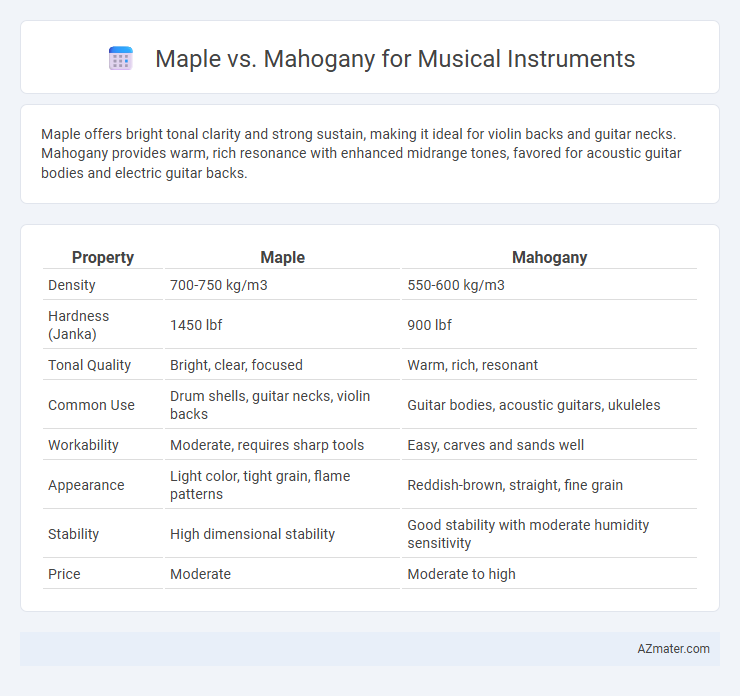Maple offers bright tonal clarity and strong sustain, making it ideal for violin backs and guitar necks. Mahogany provides warm, rich resonance with enhanced midrange tones, favored for acoustic guitar bodies and electric guitar backs.
Table of Comparison
| Property | Maple | Mahogany |
|---|---|---|
| Density | 700-750 kg/m3 | 550-600 kg/m3 |
| Hardness (Janka) | 1450 lbf | 900 lbf |
| Tonal Quality | Bright, clear, focused | Warm, rich, resonant |
| Common Use | Drum shells, guitar necks, violin backs | Guitar bodies, acoustic guitars, ukuleles |
| Workability | Moderate, requires sharp tools | Easy, carves and sands well |
| Appearance | Light color, tight grain, flame patterns | Reddish-brown, straight, fine grain |
| Stability | High dimensional stability | Good stability with moderate humidity sensitivity |
| Price | Moderate | Moderate to high |
Overview of Maple and Mahogany in Instrument Making
Maple and mahogany are two of the most popular tonewoods used in musical instrument making, each offering distinct acoustic properties and aesthetic appeal. Maple is prized for its bright, clear sound with excellent sustain and is often used for violin backs and necks, as well as electric guitar bodies, due to its dense and hard grain. Mahogany, known for its warm, rich tonal quality with pronounced midrange frequencies, is commonly used for acoustic guitar bodies and necks, providing durability and a smooth, resonant sound favored in many genres.
Sound Characteristics: Maple vs Mahogany
Maple produces bright, clear tones with strong attack and excellent sustain, making it ideal for instruments requiring articulate sound, such as violins and guitars. Mahogany offers a warmer, richer, and more resonant sound with pronounced midrange frequencies, favored in acoustic guitars and basses for its depth and warmth. The choice between maple and mahogany significantly affects tonal balance, where maple emphasizes brightness and clarity, while mahogany enhances warmth and fullness.
Durability and Strength Comparison
Maple exhibits superior durability and strength for musical instruments, with a Janka hardness rating around 1450, making it highly resistant to dents and wear. Mahogany, with a Janka rating near 800, offers moderate strength but is softer, resulting in easier damage under heavy use. The denser grain structure of maple ensures greater stability and longevity in instruments like violins and guitars, while mahogany's softness allows for warmer tonal qualities but requires careful maintenance to prevent structural issues.
Weight and Handling Differences
Maple wood, known for its density and hardness, is heavier than mahogany, which offers a lighter and more resonant feel for musical instruments. The weight difference affects handling, with maple providing greater durability and sustain, while mahogany enhances comfort and ease of play due to its lighter nature. Musicians often choose maple for instruments requiring bright tonality and solid construction, whereas mahogany suits those prioritizing warmth and ergonomic balance.
Influence on Musical Tone and Resonance
Maple offers a bright, clear tone with strong midrange presence, enhancing resonance and projection, making it ideal for instruments like violins and guitars. Mahogany produces a warmer, darker sound with pronounced low-mid frequencies, contributing to a rich, full-bodied tone favored in acoustic guitars and basses. The density and grain structure of maple result in sharper attack and sustain, while mahogany's open grain promotes a softer, more mellow resonance.
Maple vs Mahogany in Guitar Construction
Maple and mahogany are two of the most popular tonewoods used in guitar construction, each offering distinctive sound qualities and aesthetics. Maple provides a bright, crisp tone with excellent sustain and a tight grain pattern that enhances clarity and projection, making it ideal for necks and tops in guitars designed for articulate sound. In contrast, mahogany delivers a warm, rich, and resonant tone with strong midrange emphasis, favored for its durability and smooth grain, often used in bodies and necks to produce a fuller, more mellow sound.
Application in Other Musical Instruments
Maple wood is extensively used in the construction of violins, guitars, and drums due to its excellent tonal clarity, bright sound, and attractive grain patterns that enhance both aesthetics and acoustics. Mahogany, favored for its warm, rich, and resonant tones, is commonly chosen for acoustic guitars, ukuleles, and basses, providing a strong midrange and durability that suits varied musical styles. Both woods are prized in musical instrument craftsmanship, with maple preferred for instruments requiring articulate sound projection and mahogany selected for those prioritizing depth and warmth.
Aesthetic Appeal and Grain Patterns
Maple offers a bright, reflective aesthetic with tight, consistent grain patterns that enhance the visual appeal of violins, guitars, and mandolins. Mahogany features a rich, warm reddish-brown hue and a more pronounced, open grain pattern, providing a classic look favored in acoustic guitars and ukuleles. Both woods impart distinct stylistic qualities, with maple highlighting intricate grain detail and mahogany showcasing depth and warmth in appearance.
Cost and Availability Considerations
Maple is generally more cost-effective and widely available than mahogany, making it a popular choice for instrument manufacturers aiming to balance quality and budget. Mahogany tends to be pricier due to its limited availability and slower growing cycle, which also impacts long-term supply stability. Musicians and luthiers often consider these cost and availability factors alongside tonal preferences when selecting wood for guitars, violins, or other stringed instruments.
Choosing the Right Wood for Your Needs
Maple offers bright, clear tones and strong projection, making it ideal for instruments like violins and acoustic guitars that require crisp articulation. Mahogany provides a warm, rich sound with enhanced midrange frequencies, often preferred for blues and jazz guitars where a mellow tone is desired. Selecting between maple and mahogany depends on the desired tonal characteristics and playing style, ensuring your instrument complements your musical needs perfectly.

Infographic: Maple vs Mahogany for Musical Instrument
 azmater.com
azmater.com